The ones for the Jaguars work on a very simple principle, the fluid also has some very special metal (tiny) bits in it.
BHPian Jeroen recently shared this with other enthusiasts.
When it comes to air suspension there is a pretty strict divide amongst petrol heads. Some believe it is the best thing since sliced bread was invented. And some believe it is a hugely complex, and maintenance-prone, gadget at best.
However, those who have experience with air suspension will agree on one thing: It provides a superb ride! Mind you, not on all cars with air suspension. But for instance, the Range Rover air suspension gives a ride that simply is beyond your wildest imagination. There is a reason film and TV crews use Range Rovers as tracking vehicles. It is not necessary about the reliability of the vehicle as such, but the ride quality necessary for filming these fantastic driving shots. (E.g. TopGear, Grand Tour and so on)
Although I don’t have actual data, I suspect most of the air suspension systems to be pretty reliable. For no other reason, they are found on expensive high-end cars, that usually get this sort of stuff right. So I am not sure how much of the moaning on the internet when it comes to air suspension is from people who have owned air suspension-equipped cars for a long time. Just my thought.
I do know one guy, my best friend Peter who certainly raked up considerable air suspension miles; Peter is onto his third Jaguar 350. In over 800000 km (yes, that is eight hundred thousand!) he has experienced only one failure. It occurred on his first X350 after hitting 450000 (yes, four hundred and fifty thousand kilometres). It is just one data point, but even so.
I attended a technical workshop at my favourite Jaguar XJ specialist G&G Autoservices here in the Netherlands. I have written about them numerous times in my “fiddling” thread. The owners are Raymond and Joke. Raymond is one, if not the most accomplished, car guy I have ever met. He chose to specialise in not only one brand (Jaguar) but also in one type, the later Modern XJ series, so the X300, X308 and X350.
Scroll through this post to get a feel for Raymond and G&G. This is about an earlier technical day, where amongst other things Raymond pulled a complete automatic transmission apart!!
For this technical day, Raymond and his mechanic Petra had spent quite some time preparing to show us everything there is to know about air suspensions and how to troubleshoot them.
Raymond started with a prepared X350 on the lift. If you have a wheel alignment done by an outfit that doesn’t know the ins and outs of each system you might find yourself in trouble afterwards.
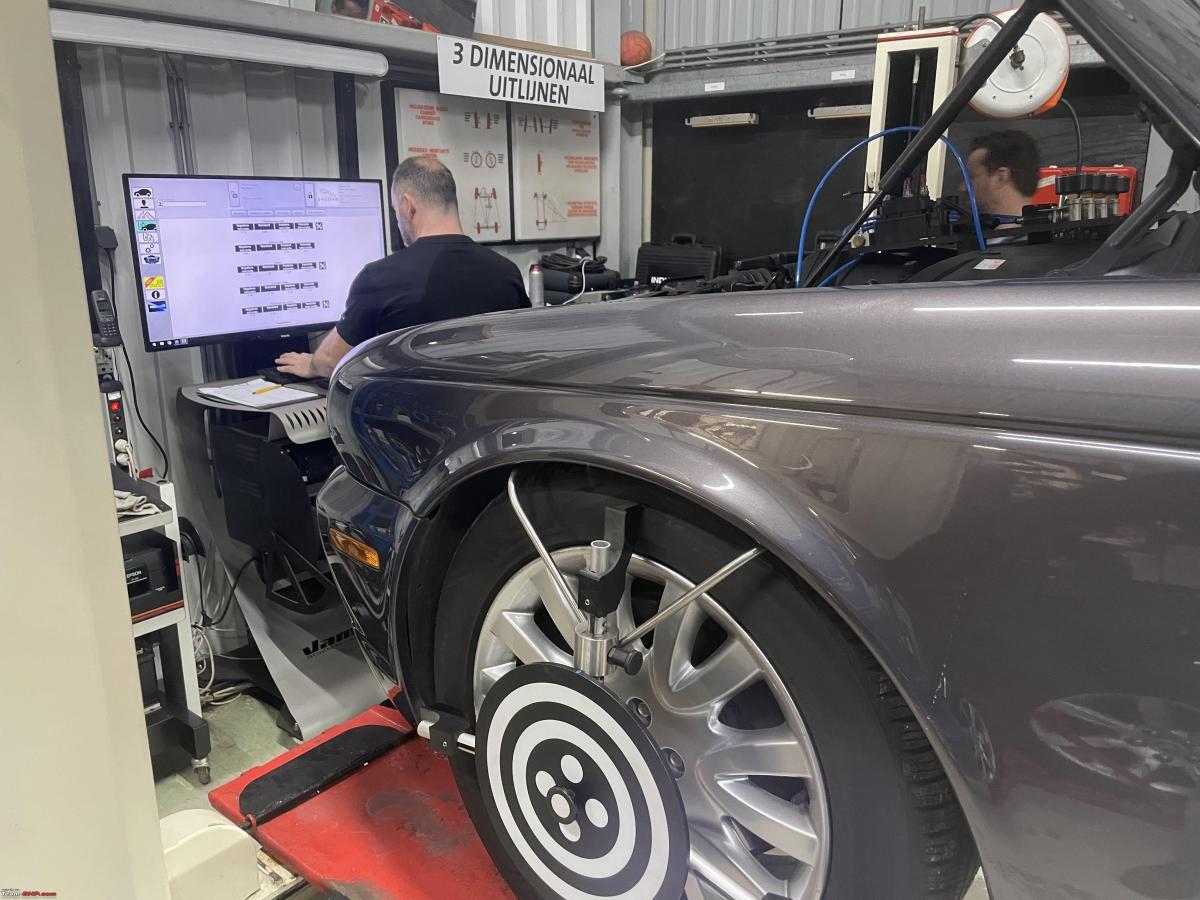
The steering wheel needs to be positioned, dead centre! Not half a degree off or so. There are only two ways to accomplish this, with a special level or on some cars, (e.g. Mercedes) the steering house provides a mechanical dead centre lock.
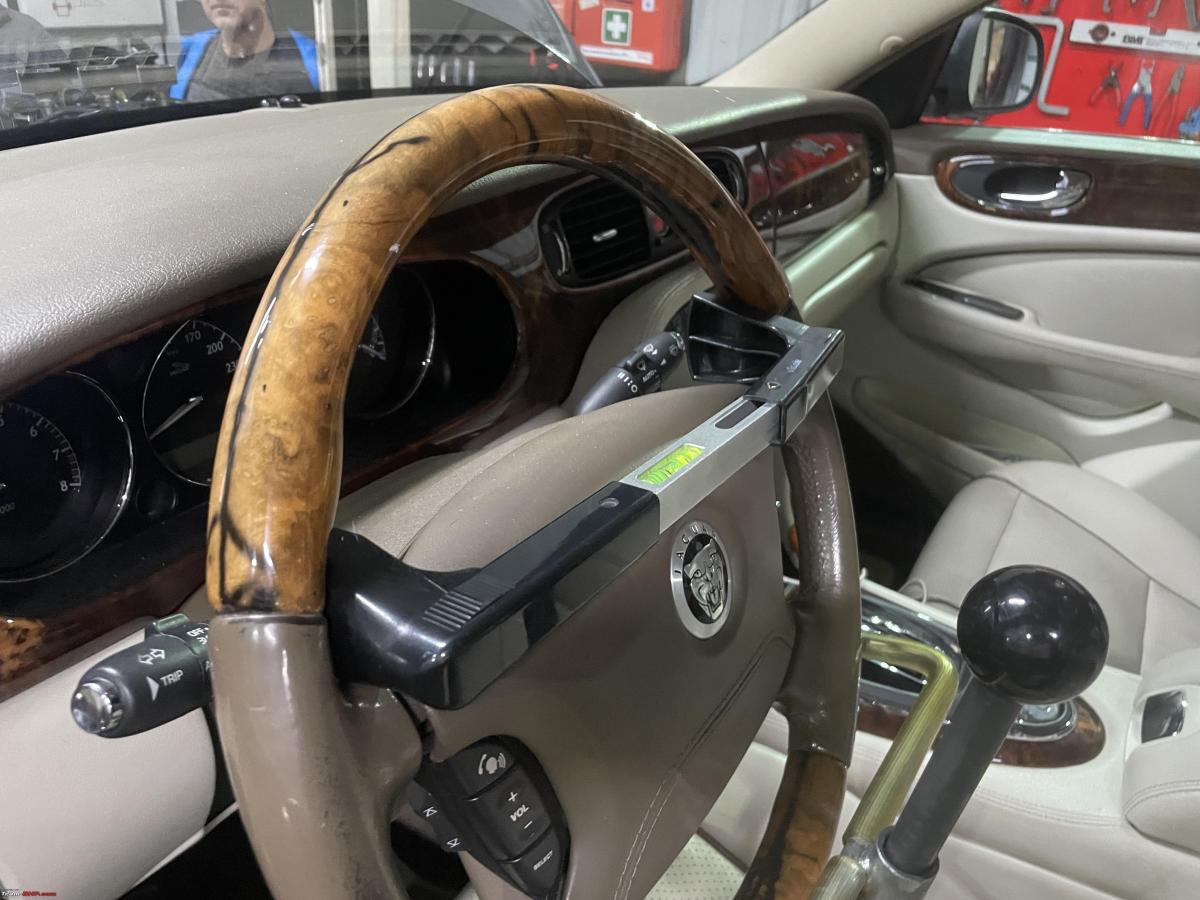
If you ever get any car aligned and they just position the steering wheel horizontally by feel/view leave immediately! On modern cars with electromechanical steering, the dead-centre position is more important than ever!!
If the connection between the steering wheel and the steering box has been worked, or the steering box has been removed for overhaul, on most cars you need to follow a very different procedure to align the steering box with the steering wheel first. (Those who follow my “fiddling” thread will have read about my experiences with the wheel alignment on my W123 after I had the steering box overhauled. None of the alignment workshops here in the Netherlands wanted to help me, as I demanded we check the steering box to steering wheel alignment first with a special dead-centre tool. Finally found a guy who knew what he was doing and was very happy to accommodate my request.
Raymond has put together this special valve manifold. With the various valves, he can operate all the different parts of the car suspension individually. Pretty nifty.
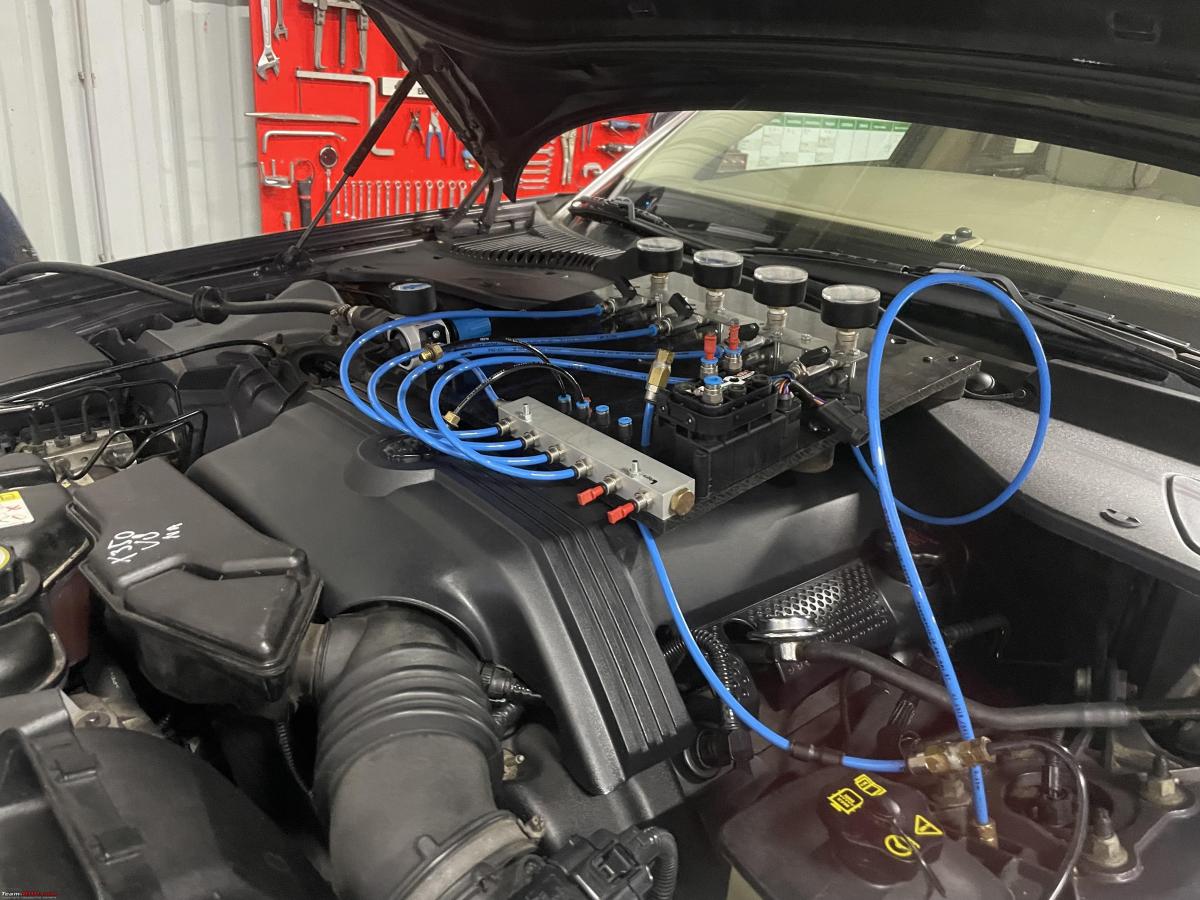
On many car suspension systems, you need to have a special OBD reader to control the suspension during wheel alignment. The Jaguar system has some 15 different modes of operation. From normal cruises, parking par, high-speed driving and so on.
As you will see, understanding how this air suspension works is crucial to be able to fix it obviously, but also to perform a wheel alignment.
By the way, the Jaguar system is very similar to the Landrover system as you would expect. Even though the components look identical they can not be interchanged. Each component has a unique electronic code, that will allow proper operations only on a Jaguar or Landrover.
Raymond and Petra had built a small demonstration rig. Raymond added all the different components of the system during his talk. Just so we all got a good idea of what the components look like, what they do and how they interact with all the other components.
As you can see the basis of the system is four bellow in each of the wheel struts.

The system operates on a nominal pressure between 7 and 9 bar inside the bellows Just above 7 bar the car is being lifted. However, the air reservoir is kept at 15 bars.
Here you see it. It has a manifold with several electrical controlled valves.
At the front, the bellows are quite a bit larger than at the rear. The front is heavier with the engine, but also it needs to accommodate larger forces when braking.
Next comes the compressor. Sits underneath the left-hand fender sort of.
These are quite capable compressors. They compress air up to 15 bars and must do so in a short space of time. As they are air-cooled, the compressor won’t run until the speed is at 45 km/h. Even so, they are protected against overheating, so they will be switched off automatically after 2m minutes. A new original Jaguar compressor will fill the system in probably half to one minute. So it will switch off on the pressure. Non-original compressors often can’t get the system up to the required pressure in under 2 minutes. So they get switched off by the timer before adequate pressure has been reached.
Here you see two compressors. The one on the left is the original one, the one on the left is a non-Jaguar brand. The price difference is staggering, literally several thousands of euros. An original Jaguar compressor costs about Euro 3000 (INR 270000).

The compressor does come with an air inlet filter and moisture absorptions. The latter needs regular attention as it can become saturated. One thing is how the various OBD error messages show up. The error message so-called “reservoir not plausible” could be due to problems with the compressor.
Next Raymond showed us the level sensors. Essentially a lever that rotates a potentiometer. The suspension computer calculates based on the level sensor, and a bunch of other parameters how much air should be directed to each of the four bellows.
Interestingly, the X350 has only one of these sensors at the front and two at the rear! The whole system is set up and calibrated by having the driver behind the wheel. So there are different computers for right-hand and left-hand drive Jaguars. And no, they are not interchangeable.
One of the reasons for having g two-level sensor is that the air suspension system also works in tandem with the ESP system. There are also other aspect of the car that are relevant to the air suspension. For instance, the steering angle sensor is an input to the suspension computer.
There are also two acceleration sensors fitted at the front of the car. One for horizontal and one for vertical acceleration.
Sorry, poor image, but you can just make them out I hope
Each suspension strut is equipped with a special air check valve that ensures a pressure of at least 3 bars is maintained at all times. These struts are shipped from the factory with 3 bars of pressure. So one of the checks Raymond does is check the pressure when receiving new struts.
Here you see the little valve, Rayond demonstrated with his nifty pneumatic control board the operation of these little, but important valves.
I trust by now you are beginning to get a feel for the complexity of this air suspension system. And why even a relatively simple wheel alignment needs to be done by somebody who understands this system.
Just to summarise a couple of the must-knows: The compressor will not run at speeds below 45 km/h. (a bit tricky with your Jag on the lift). When the engine gets switched off, depending on various parameters the car will start to drop height after about 120 seconds. The calibration of the system, and thus the wheel alignment, is based on somebody sitting behind the wheel. And the list goes on. So unless you know what you are doing, or have the correct equipment to simulate the correct position of the car on all four bellows before alignment it is going to go badly wrong.
Raymond showed us the various alignment readings in different positions. I was quite amazed to see how big an error you get!
The system is designed in such a way that each strut, or rather bellow, can only lift a quarter of the total weight of the car. Well, a little more.
Now let’s have a look at the actual struts. They are comprised of a spring, a damper and the bellow.
Here you see the complete strut in a special Tool Raymond has recently purchased. Complete struts cost around Euro 2600 -3000. Raymond is going to over a special service to his customers to replace only the bellows and or the struts. Replacing the bellows is not offered by anyone yet. Most garages and workshops will just swap the original Jaguar strut for an aftermarket one. And that often leads to problems and disappointment.
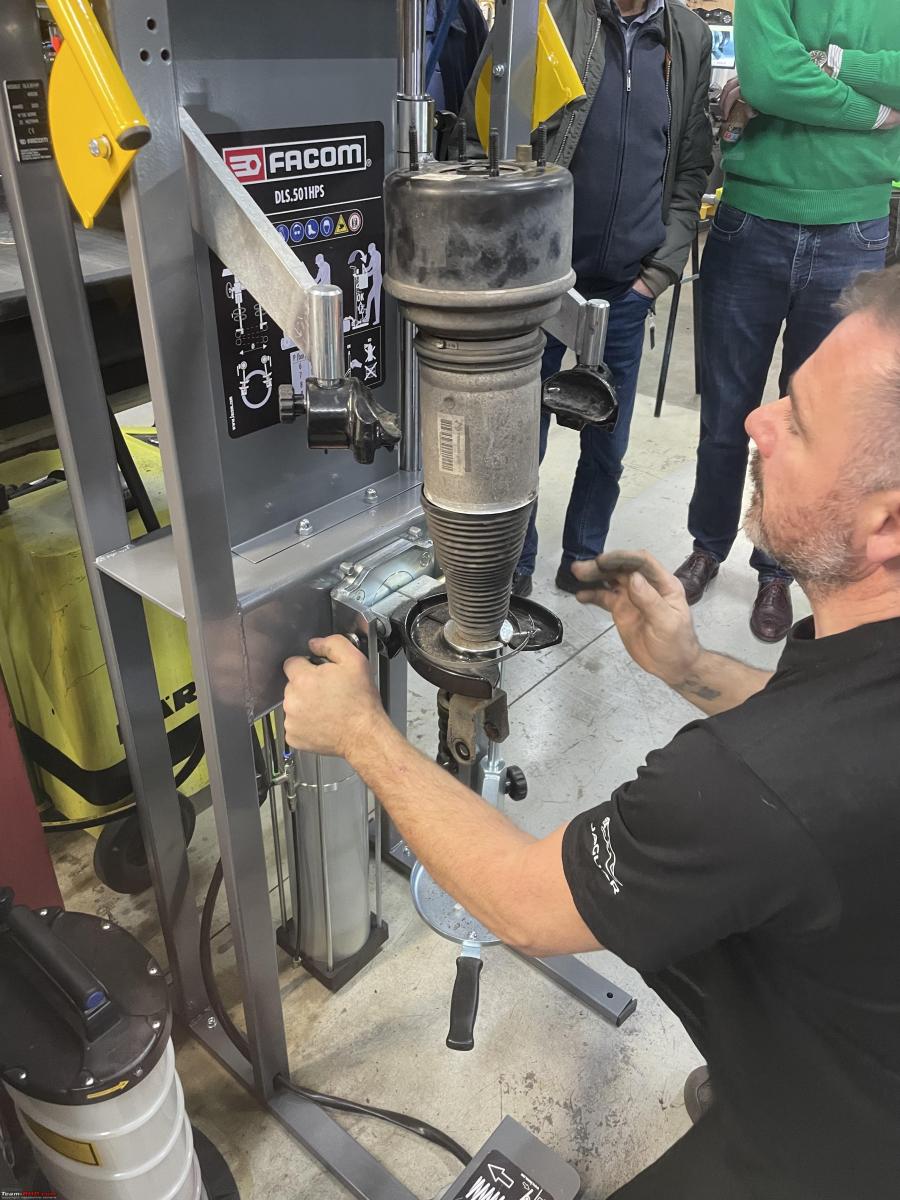
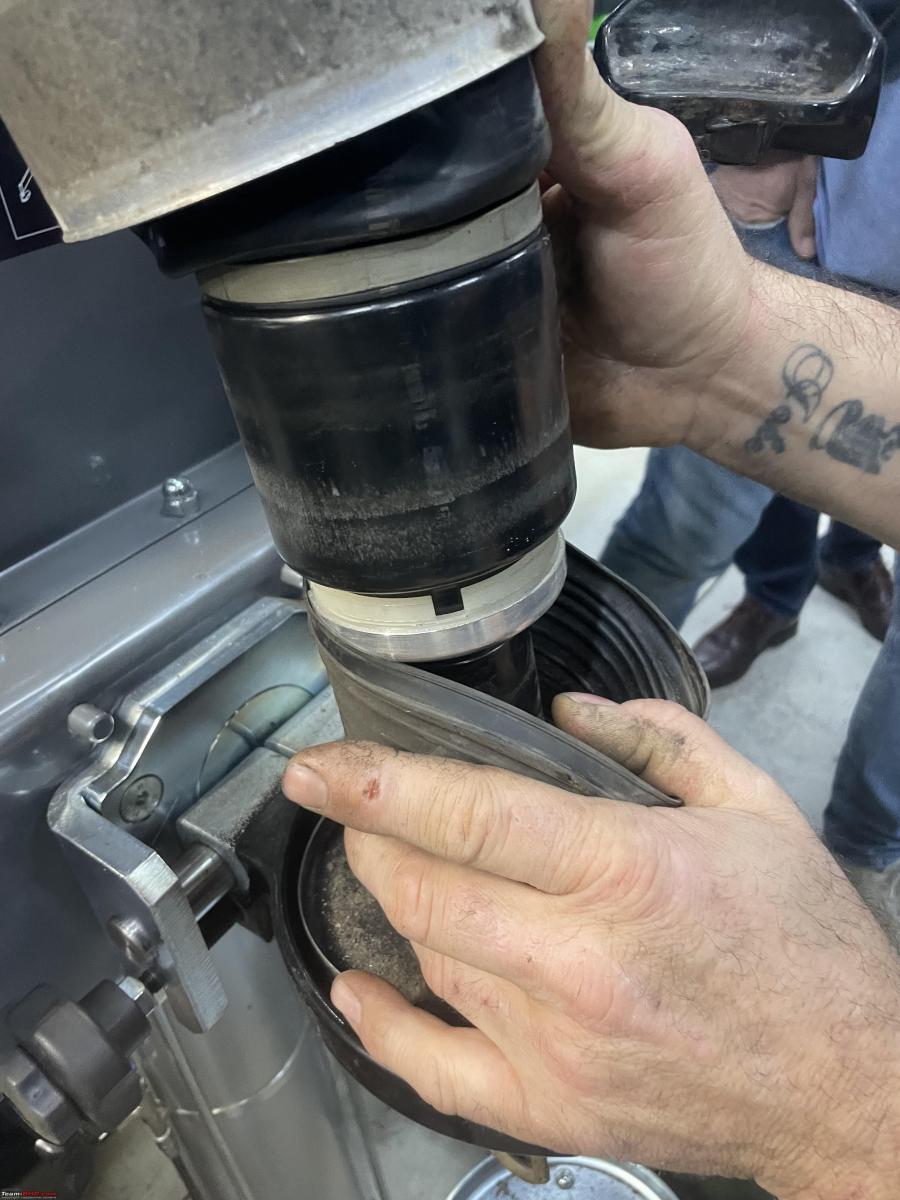

The damper is, similar to my Jaguar (XJR/X308) a so-called active damper. Jaguar calls it CATS (computer-operated active suspension control) ). On an active damper, the charasterstics of the damper can be adjusted. E.g. for different kinds of roads and terrain. These are all Bilstein. They cost a huge amount of money. The ones for the Jaguars work on a very simple principle, the fluid also has some very special metal (tiny) bits in it. An electro-magnetic valve controls the flow of the fluid. Due to the metal bits in it, its viscosity can be altered, extremely quickly.
On my Jaguar the system is always active and provides primarily anti-body roll. My X308 corners like you would not believe!!
On the X350 the dampers are switched on and off, by the suspension computer and are an integral part of the control cycle of the suspension.
Raymond talked us through endless different scenarios of how the system would react and how to troubleshoot various problems and come to a solid diagnosis.
All in all, again, another very interesting workshop. Many thanks to Raymond, Joke and Petra for all the preparations and an excellent lunch!
Check out BHPian comments for more insights and information.






